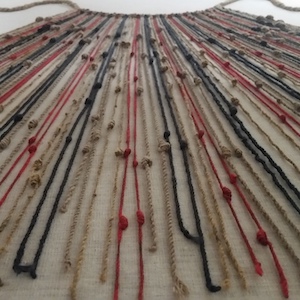Long Teaching Module: Inca Society
Overview
In South America in the centuries before 1500, the Peruvian coast and Andean highlands were home to a series of cultures that cultivated cotton as well as food crops. Of these, the largest empire was created by the Incas, who began as a small militaristic group and conquered surrounding groups. The Incas established a far-flung empire that stretched along the Andes, keeping this together through a system of roads, along which moved armies and administrators. Gradually, Inca culture spread throughout Peru. Andean society was dominated by clan groups, and Inca measures to disrupt these, move people great distances, and collect tribute created resentment. They relied both on leaders of the conquered people and officials sent out from their capital at Cuzco to enforce their demands for payments. The seven sources for this module include short sections of three chronicles, a report, two line drawings, and a khipu.
Essay
Inca was originally the name of the governing family of an Amerindian group that settled in the basin of Cuzco in the Andes Mountains. From that family, the name was gradually extended to all peoples living in the Andes valleys, and was also used for the ruler or emperor. The Incas believed their ruler descended from the sun-god and that the health and prosperity of the state depended on him. Dead rulers were thought to link the people to the sun-god, and religious concepts created pressure for imperialist expansion. Under Pachacuti Inca (1438-1471) and his successors, Inca domination was gradually extended by warfare to the frontier of present-day Ecuador and Colombia in the north and to the Maule River in present-day Chile in the south, an area of about 350,000 square miles. Eighty provinces, scores of ethnic groups, and 16 million people came under Inca control.
Imperial unification was achieved in part through the forced participation of local chieftains in the central bureaucracy and through a policy of colonization. To prevent rebellion in newly conquered territories, Pachacuti Inca and subsequent rulers transferred all their inhabitants to other parts of the empire, replacing them with workers who had lived longer under Inca rule. They drafted local men for distant wars, breaking up kin groups that had existed in Andean society for centuries. An excellent system of roads—averaging three feet in width, some paved and others not—facilitated the transportation of armies and the rapid communication of royal orders by runners. Ruling an empire requires a bureaucracy as well as an army, and Inca officials, tax collectors, and accountants traveled throughout the empire.
The ayllu, or clan, served as the fundamental social unit of Inca society. The ayllu held specific lands, granted it by village or provincial authorities on a long-term basis, and individual families tended to work the same plots for generations. Land was owned by the ayllu, not by individuals, with parallel lines of descent; women achieved access to resources such as land, water, and herds through their mothers, and men through their fathers. Cooperation in the cultivation of the land and intermarriage among members of the ayllu wove people there into a tight web of connections. The main staple crops were various types of potatoes in highland areas and maize in more low-lying areas. Villagers often built terraces, separated by stone retaining walls, on the steeper slopes to plant their crops, and irrigation channels and ditches to bring water to the fields.
In return for the land, every family had to provide crops for the Inca nobles, bureaucracy, and religious personnel, and also send a person to work a certain number of days per year at other tasks. These included military service; building and maintaining palaces, temples, roads, and irrigation systems; terracing and irrigating new arable land; acting as runners on the post roads; weaving and dying cloth; and excavating imperial gold, silver, and copper mines. The Inca had a cult of the sun, and a large number of other gods and revered ancestors. This labor tax, called the m’ita, was rotated among households in an ayllus throughout the year, with some labor required of each household every year. Certain young women were chosen as acclas (women dedicated to the sun), and either remained virgin-priestesses in special buildings or married the Inca or one of his favorites. The Incas demanded such women from all the peoples they conquered.
The government also made an ayllu responsible for maintaining state-owned granaries, which distributed grain in times of shortage and famine, and supplied assistance in natural disasters. The Incas had well-established mechanisms for the collection of agricultural goods and the imposition of the m’ita. The emperors sometimes gave newly acquired lands to victorious generals, distinguished civil servants, and favorite nobles.
As the Inca Empire expanded, this pattern of social and labor organization was imposed on other, newly conquered indigenous peoples. After the conquest, the Spaniards adopted and utilized the Incas’ ways of organizing their economy and administration, just as the Incas (and, in Mesoamerica, the Aztecs) had built on earlier cultures.
The Incas did not develop a system of writing before the arrival of the Spanish, but Inca officials recorded statistical information, including tax data, on quipus, which were collections of knotted cords of various colors and lengths, all suspended from one thicker cord. The ability to read quipus has been lost; however, early Spanish officials sometimes recorded the words of people who were reading these quipus and a few native or mixed-race individuals wrote chronicles based in part on quipus, so that the information they contained has not been completely lost. These records were, of course, written in Spanish or Latin, not Quecha (the language of the Incas), and there were certainly some misunderstandings, but they are still very Valuable.
How I Introduce These Sources
The seven sources in this teaching module include material, visual, and written sources. The first is a short extract from Juan de Betanzos’ Narrative of the Incas, written by a Spanish conquistador who married the chief wife of the last Inca emperor, and based on her experiences and recollections. Questions to pose to students as they read this: What happened to the ruler’s body and his wealth after he died? Why might such practices haves been economically harmful? How might the Inca have sought to gain new resources to support this cult of dead emperors?
The second source is a quipu, which I include so that students have an idea what these looked like. The third is a report from a Spanish inspector dating from 1549, written by a
European scribe, based on an Andean’s reading of a quipu. This comes from the Huallaga Valley, an area that had put up strong resistance to Spanish rule and had been conquered only in 1542. Spanish authorities wished to know about the obligations imposed by the Incas on the Chupaychu, the main ethnic group in this area, whom the Incas deemed to have consisted of 4000 households. Questions to pose to students as they read this: According to this report, what types of labor had the villagers been required to do? What does this tell you about Inca lifeways? If all of these labor obligations were actually met (which we have no way of knowing), how many villagers were engaged in labor for the Incas, and how many in basic food production or care of animals? How much of the labor demanded of conquered villages is for military purposes? What do the various types of and levels of labor demands tell you about Inca imperialism?
The next two sources are chronicles written in Spanish that also describe the taxation system of the Incas. Both of the authors are generally favorable to the Incas, viewing them as benign conquerors, which may have influenced their reporting on Inca demands. Questions I pose to students: According to these authors, what types of labor are required of the villagers? How are the laws requiring tribute enforced? Who was liable to pay labor tribute? How do these authors assess the level of labor service required? Do you think that conquered peoples would feel the same about this? How does their assessment fit with the information recorded in the report from the 1549 report from the Spanish inspector?
The Incas’ creation of an empire was cut off by the Spanish conquest, but Spanish authorities built on Inca foundations when they assessed taxes and work duties owed by
indigenous communities. This was the main reason they were so interested in finding out exactly what the Inca system had been, and why they sent out officials and scribes such as those who produced the 1549 report.
The final sources in this module are two illustrations from El Primer Nueva Coránica y Buen Gobierno [The First New Chronicle and Good Government] (1615), a thousand-page
history of the Inca Empire and the Spanish conquest of the Andes written and illustrated by Filipe Guaman Poma y Ayala, an indigenous Peruvian Christian noble. Guaman Poma’s text includes nearly 400 full-page line drawings that portray many aspects of Inca life, as well as historical events before and after the Spanish conquest. These two drawings show men and women harvesting potatoes and a woman weaving on a backstrap loom, both tasks described in the reports about labor obligations. Questions to pose about these: What do they reveal about the gendering of work in Inca society? How does this fit with the information about men’s and women’s roles in the written sources?
Primary Sources
Bibliography
Additional Resources:
The Danish Royal Library has produced high-quality digital reproductions of every one of Guaman Poma’s illustrations, which can be used to teach many aspects of Inca life and that of early colonial Peru. They are available here: http://www5.kb.dk/permalink/2006/poma/info/en/frontpage.htm/
Credits
About the Author
Merry Wiesner-Hanks began her career as a historian of early modern Europe, with a research focus on women’s work in Germany. When she moved to UWM, her teaching responsibilities came to include the history of Christianity, and her research interests also increasingly focused on religion, especially issues of gender and the Protestant and Catholic Reformations. At the same time, she began to write and publish various types of source books designed for use in the classroom and to teach courses in world history. This took her into geographic areas and time periods far away from early modern Europe, and her research expanded as well, becoming global as well as European. Since 2000, she has worn these two hats, one as a historian of early modern Europe and the other as a world/global historian, with a primary focus on women, gender, and sexuality within these.





